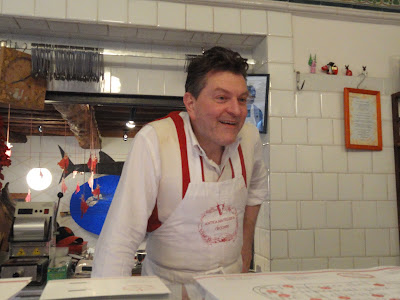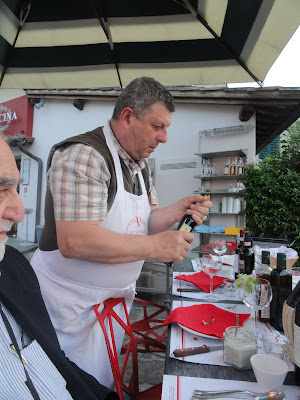Praise Dario Cecchini!
Dario Cecchini, pictured above, bursts with enthusiasm, a flamboyant personality who comes from a long line of butchers, at least 600 years of history! It is claimed that Dante Aligheri and Leonardo da Vinci both were patrons of Cecchini butchers. Dario himself can quote from Dante at length, and he also loves to sing. He is a showman, yet it is also clear that he is quite adept at his butchery skills, having been a butcher for about 35 years. He treats his customers like family, or at least members of the same fraternal society, the lovers of meat in all its forms.
During our visit to the Chianti Classico region, we stopped one evening at the Antica Macelleria Cecchini, Dario's butcher shop in Panzano, where we witnessed him chopping up some steaks off a large hunk of beef. He effortlessly and skillfully wielded his cleaver and knife, creating a fine stack of steaks. Yet this was but the preliminary before dinner as above the butcher shop, hidden behind a secret door, is the Officina della Bistecca, his restaurant which is an homage to all things beef. We passed through the secret portal and climbed the stairs to the restaurant, as if ascending to a carnivore heaven.
But before ascending, we need to return to the exterior of the butcher shop, to view two marble signs, on the outer wall, which speak volumes about Dario. The top one is a memorial to the "death" of bistecca alla fiorentina, the famed Steak Florentince of this region. In 2001, due to worries about mad cow disease, some cuts of steak were banned in parts of Europe, including Italy. For example, meat attached to the bone of cattle older than one year was prohibited for sale. The bottom sign is more cheerful though, as it commemorates the lifting of the ban that occurred five years later.
Bistecca all fiorentina is essentially a T-bone steak which has been simply grilled until it is still a bit rare, and olive oil and salt are the only condiments. It allegedly acquired its name from English travelers who were quite pleased to find a familiar "beefsteak" for dinner in Tuscany. The bistecca used to be primarily made from Chianina cows but as it has become expensive, many restaurants now use less expensive beef. Dario though has been instrumental in bringing back the use of Chianina cows to the Tuscan region.
Where does Dario get his Chianina? Since childhood, Dario has been friends with Giovanni Manetti, the owner of Fontodi winery. Giovanni raises, naturally, about 30 Chianina cows and 1 bull on his estate. While visiting the winery, we also got to see his cattle. Giovanni provides Dario with one cow per month for his restaurant and he does not sell his cows to anyone else. When Giovanni was a small boy, his father used to own about 100 cows, and Giovanni is caring on a family tradition.
The Chianina breed may extend back to the ancient Etruscans and they have long been revered for their beauty and expressiveness. They may have originated in the Val di Chiana, from which they derive their name, which once was a fertile plan where they could easily graze. Unfortunately, during the Middle Ages, the nearby rivers flooded, turning the plain in swampland so the cows had to move elsewhere in Tuscany. In the late 18th and early 19th centuries, the swamps were drained and the plains became fertile once again.
The cattle were primarily used as draft animals and with the advent of mechanization, their numbers started to decline as it was expensive to raise these animals. They require more pasture land than other cattle, and they are very particular in what they eat. In 1960, there were approximately 400,000 Chianina in Tuscany and by 1980, that population had decreased to 100,000. Today, it is even worse, as there are less than 30,000 Chianina cattle left. Interestingly, though they were used for work and meat, they were not used for the production of milk or cheese.
Chianina are typically white, except for their first three months when they have a brown coloration, which will fade away. There is little marbling in their meat, which means there is not much fat, so dry aging of the meat for 30-40 days is suggested. But the meat is dark red, juicy and quite delicious with a clean taste. After dining on their meat, I have become a huge fan.
For dinner, we ate outside at communal picnic tables (though it is also possible to sit inside the restaurant if you prefer). I loved the communal tables though as it promoted a happy and festive environment, and we got to meet new people. It was an experience without pretension, and it almost felt like you were eating with family or close friends. The meal is a prix fixe for only 50 Euros per person, and it includes food, wine and after dinner spirits. I think it is an excellent value for the quality and quantity you receive and I would highly recommend it, unless you are a vegetarian.
The menu includes five courses of beef: Chianti Crudo (beef tartar), Brustico (seared beef), Costata alla Fiorentina (bone-in rib eye or strip steak), Bistecca Panzanese (Panzanese steak), and Bistecca Fiorentina (T-bone or porterhouse steak). Plus, you receive Pinzimonio di verdure dell'orto (fresh, raw garden vegetables), Fagioli all'olio (Tuscan beans with olive oil), Patate al cartoccio (baked potatoes), Burro del Chianti (Chianti "butter" aka lard), and Pane Toscano (Tuscan bread). For dessert, you receive Torta all'olio (olive oil cake), coffee, Grappa, and Italian military spirits. That is plenty of food so you better ensure you are hungry when you go.
Dario has his own Chianti Classico, served in a fiasco, which is included with your dinner but you can also bring your own wine without a corkage fee. That makes it an even better value.
We brought a number of Chianti Classicos with us for dinner, and my favorite was probably the 2010 Castello di Querceto Chianti Classico, a silky smooth and elegant wine with nice red fruit flavors. It seemed to pair so well with all of the beef dishes.
The beef tartare was amazing, the tender meat melting in your mouth with a spicy aftertaste. It was made very simply, with some lemon and spices, lacking the capers, egg, and other ingredients you often see in beef tartare in the U.S. Yet it didn't lack flavor in the least and I had a couple portions. The Brustico was almost like a grilled steak tip, and was also very tender, simply prepared and had a very savory aspect to it. With superb ingredients, you don't have to add much to present a bounty of taste.
Both the Costata alla Florentine and Bistecca Panzanese were cooked medium rare, though tending toward the rare, which is exactly how I enjoy my beef. Once again, the beef was tender and flavorful, appealing to the primeval carnivore lurking within me. They were generous too, giving people more meat if the guests so desired.
And of course the Bistecca Fiorentina was superb as well, as expected. Though I think some of the attendees were too full by this point to truly enjoy it. Forget all those steak sauces and glazes, this simple steak needed no accompaniment. At this point, after the bistecca, I was quite sated, and immensely happy. It was such a fun and tasty evening, catering to my love of beef. Service was excellent, everyone so personable and accommodating. A perfect evening.
At the end of the evening, it was time for some olive oil cake, which was good but it was hard to eat much after all of that beef. It was also time for some digestives, including some of Darios' own Grappa, a potent spirit.
I was most intrigued though by the Enocordial, a "military spirit," as I had never heard of that designation before. This is a Brandy that was aged for at least 3 years in oak and might be based on a historical recipe from the Military Farmacopea of 1877. It was a potent spirit as well, though I actually preferred it to the Grappa as it was a bit smoother.
So, if you are a buona forchetta, a "good fork," (which refers to an "enthusiastic eater") and you love beef, then you must pay homage to Dario Cecchini and dine at his Officina della Bistecca. I will treasure my own memories for a very long time and Dario receives my highest recommendation.
Viva la ciccia!



















1 comment:
Interesting take for sure. I found the Crema Paradiso, or Chianti Butter to be the best part of the meal. Personally, as riveting as the presentation is, all the Chianina tastings are very tough and almost "watery" in flavor compared to other "beefy" flavored cattle.
Post a Comment